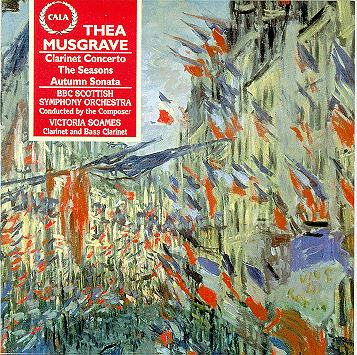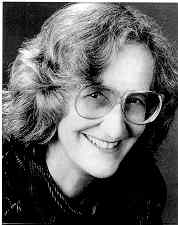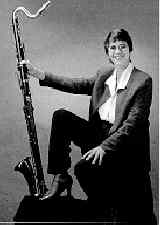| Cala records have recently released a CD containing Thea Musgrave's Clarinet
Concerto. I have known this work since it was first issued on LP by Argo
(ZRG726 8/75) following a Decca Headline release of the Concerto for Orchestra
and the Horn Concerto (HEAD 8 6/75). All have long disappeared and I was
surprised by the existence of the present CD because I had been awaiting
a new recording. I had even tried unsuccessfuly to interest Brian Couzens
of CHANDOS in recording this composer.
The CD arrive this morning and it is so captivating that I have given up
a morning's work to hear it and to post this. It is a CALA release and I
must have got hold of a review copy being sold on as it is a new recording
which I do not believe has even been advertised or reviewed yet.
The details are:
Concerto for Clarinet and Orchestra
The Seasons
Autumn Sonata (Concerto for Bass clarinet and Orchestra)
with Victoria Soames soloist on clarinet and bass clarinet.
BBC Scottish Symphony Orchestra conducted by Thea Musgrave
Recorded in Glasgow City Hall last April
CALA: CACD1023
Now reissued as Clarinet Classics CC0035
Crotchet
AmazonUK
The notes are written by Thea Musgrave in a dispassionate third-person style
e.g "We hear three musical elements .... each of which, it transpires, has
individually been hinted at throughout the concerto."
Thea may have started out being influenced by Schoenberg, Webern and her
teacher William Glock but that is not how I hear her music at all (I have
not heard any of her Operas). I find her music modern but approachable, sensitive
and responsive without any sudden unecessary dramatic outbursts that leave
you wondering what on earth hit you. Her compositions would certainly leave
the old ladies unruffled on the front row! She does not write big tunes for
her soloists in the way Alwyn or Walton have - her soloist parts tend to
be rather spiky but cushioned by a lyrical underpinning in the orchestra.
The Clarinet Concerto (26:20)(Royal Philharmonic Society Commission, 1968)
was written for Gervase de Peyer who made the first recording, which is rather
academic as it is not available and it is unlikely Polygram will get round
to re-issuing it. Thea writes that the concerto depicts a struggle between
unequal forces - the individual versus the crowd. The soloist begs support
from sections of the orchestra and does this by the peripatetically moving
to different sections of the orchestra and persuading them to play as separate
units independently of the conductor. This same idea is also taken up in
other works of hers such as the Night Music for chamber orchestra which has
two horn players doing the same (ARGO 702 nla). In one unusual alliance the
soloist pairs up with an accordian which is particularly well caught in this
recording.
I have always loved the sound of the bass clarinet, particularly when used
by Shostakovich, but I have never previously heard it used as a solo instument
in a concerto. Again the sound has been beautifully caught by the engineer
(Graeme Taylor) and I have been fascinated by the range of the instrument.
The Autumn Sonata is a dark, brooding, atmospheric concerto in six parts
(21:38) and was commissioned by the present soloist, Victoria Soames, who
gave the first performance at the Cheltenham Festival in 1994. Musgrave had
previously set a poem by the Austrian Poet, Georg Trakl, in "Wild Winter"
and was inspired to write this piece by other of his writings. Each section
of the Concerto is prefaced in the score by short fragments from four different
poems. Thea Musgrave describes each section as follows:
"i Oscuro e misterioso
A dreamer approaches a dark menacing forest, where crows scatter at the sound
of black footsteps.
ii Svegliato
Mysterious dark forces awaken and bells toll the alarm
iii Alla marcia, con furore
The echoing sound of deadly weapons erupts and culminates in a pounding march,
the major climax of the work.
iv Lamentoso
Eventually the march subsides and the dark flutes of Autumn greet the ghosts
of heroes. Here the ancient chant, Dies Irae, is embodied in the musical
texture in much the same way as it was in the setting of the Trakl poem in
"Wild Winter".
v Oscuro e misterioso
A reprise of the opening section.
(Here we have the bonus of two Bass Clarinets as an offstage instrument "shadows"
the soloist and the work momentarily becomes a double concerto for Bass
Clarinet.)
vi Adagio sostenuto
The coda where .... the music .... culminates in a quotation from Beethoven's
Moonlight Sonata."
Finally the black mood is dispelled and the music fades; was it really a
memory or just a dream?
The middle work on the disc is orchestral: "The Seasons" (25:26) and was
a commission from The Academy of St Martins in the Fields in 1988; the first
performance was conducted by Sir Neville Marriner. This work is in four movements
(Autumn, Winter, Spring and Summer) and each movement was inspired by paintings
rather than poetry. Thea (who is resident in the States) had visited the
New York Metropolitan Museum of Art and on viewing Piero di Cosimo's "Caccia
Primitiva", which depicts "a frightening image of fire and destruction built
around a wild and gory hunt scene" she was struck by the idea that various
art works that depicted the four seasons could also "become a metaphor for
the cycles in the life of man".
Thus the "Autumn" movement was inspired by Picasso's "The End of the Road"
and depicts a violent tempest. "Winter" is despair in an icy landscape derived
from viewing Leutze's "Washington Crossing the Frozen Delaware" and there
is a brief quotation from the "Star Spangled banner". The thaw comes in "Spring"
where the melt water dripping from the ice is clearly heard, the awakening
birds and finally the cuckoo as the harbinger of spring; the painting here
was Van Gogh's "The Sower". Finally "Summer", a movement of rejoicing and
celebration. The paintings here were Van Gogh's "Le 14 juillet a Paris",
Jasper Johns' "Flag" and Monet's "Rue St-Denis, Festivities of June 30, 1878".
For Nature this is the final liberation from Winter and for Man liberation
from tyranny.
Glasgow City Hall is obviously a good recording venue as the engineers have
produced a very natural recording with good depth to the orchestra and a
"hall feel" without the undue resonance that BIS often achieve.
You may not be able to purchase this disc as cheaply as I did but I am sure
you will not begrudge whatever you have to pay for it.
Len Mullenger
Since January 2000 you are visitor
number

|




 Return to
Index page
Return to
Index page